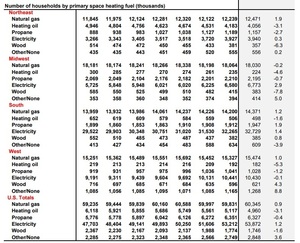EIA predicts higher winter heating costs, drop in wood heating
Energy Disrupter
ADVERTISEMENT
The U.S. Energy Information Administration on Oct. 12 released its 2022-’23 Winter Fuels Outlook, predicting that U.S. households will face increased energy costs this winter due to higher fuel prices combined with higher heating demand due to expected lower temperatures. The agency also predicts that then number of U.S. households using wood as a primary heating source will decrease.
Heating costs associated with the use of natural gas, heating oil, electricity are all expected to increase this winter. When compared to last winter, the agency forecasts expenditures for homes that heat with natural gas will rise by 28 percent, heating oil by 27 percent, electricity by 10 percent, and propane by 5 percent from October through March. Temperatures are expected to be slightly colder than both last winter and the average winter for the previous 10 winters, according to the National Oceanic and Atmospheric Administration’s most recent winter forecast.
According to the EIA, approximately 46 percent of all U.S. households heat primarily with natural gas, while 41 percent heat primarily with electricity, 5 percent heat primarily with propane, 4 percent heat primarily with heating oil, and 1.3 percent heat primarily with wood.
The EIA estimates that more than 1.7 million U.S. households, or 1.3 percent, will use cord wood or wood pellets as the primary fuel for residential space heating this winter. As of 2020, the agency estimates that another 7 percent of households will use wood as secondary source of heat, second to electricity as a supplemental heating fuel for U.S. households. Wood is more widely used in rural homes, with 22 percent of rural U.S. households using wood for primary or secondary space heating, compared to 6 percent of urban households. Wood use was most common in New England, where 16 percent of households used wood as either a primary or secondary source of heat.
For the winter of 2022-’23, the EIA predicts that the number of U.S. households using wood as a primary heating fuel with fall by 1.6 percent, to 1.746 million. An estimated 357,000 households in the Northeast will use wood as a primary heating fuel, down 6.3 percent. The use of wood heating is also expected to fall by 7.8 percent in the Midwest to 383,000 households. Households heating primarily with wood, however, are expected to increase by 0.8 percent in the South and 4.3 percent in the West, reaching 385,000 and 621,000 households, respectively.
















